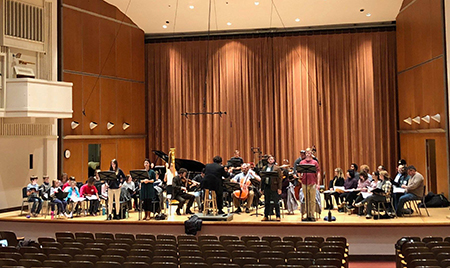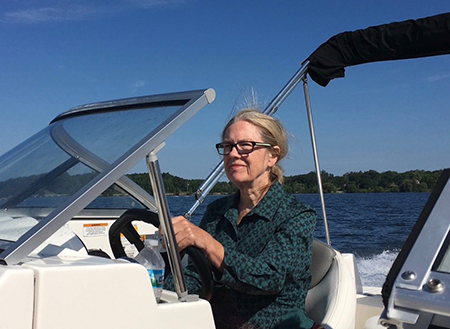by Mike Telin

The revised version will be presented on Friday, October 19 at 7:00 pm at Kulas Hall at the Cleveland Institute of Music (above, rehearsal photo). The performance features soprano Angela Mortellaro, mezzo-soprano Sarah Beaty, tenor Brian Skoog, bass Bryant Bush, the Blue Streak Ensemble and Chamber Singers, and the Cleveland Institute of Music Children’s Choir, all under the direction of Domenico Boyagian. The performance will be video-recorded for future broadcast. Tickets are available online.
Written in four parts, the oratorio is a musical description of Lake Erie during the first quarter of the 21st century. While the work portrays the Lake’s magical side — waves splashing on the rocks, walks on the beach, children playing in the water, and the pleasure of a fisherman in his boat — it also highlights the Lake’s many environmental problems as well as the innovative attempts that are being made to combat those problems.
“Believe it or not, I have spent another year working on this oratorio,” Brouwer said during a telephone conversation, noting that with works such as this, revisions are common. “Operas are almost always revised after the premiere. And honestly, it probably could have gotten other performances the way that it was, but I was not happy, especially with Part Four.”
The composer said that the revised version of Voice of the Lake focuses on factual information in the libretto, veering away from using poetic lines. “I have changed many of the words because feedback from audience members was that the poetry did not work in the context of the other somewhat scientific, environmental language. The music is the same, but the words have changed.”
The revised version also contains two new arias. “There’s a big aria for the tenor in Part Four. It’s very operatic — about eleven minutes long. The character goes through a real personality change because earlier in the piece he’s representing the U.S. Army Corps of Engineers, and here he’s walking along the lake and sees the green algae, which makes him realize that something has to be done. The idea for the new aria for the mezzo is that she and the soprano have been on a canoe trip on the Maumee River and they are sharing photos. Most of the new music is in Part Four, but it still ends with the children singing.”
Later this month, Brouwer will take the production to Cincinnati for a performance at The North American Lake Management Society during their International Symposium. “There was so much attention given to it on the radio after the premiere last year. The entire recording, along with an interview with me, was played in New Jersey on Earth Day. I was also interviewed on NPR with snippets of the music. People from around the country heard the interview and they started corresponding — they said lake management is what we do, and that’s what the piece is about.”
Part One of the oratorio was performed at the Museum of Natural History as part of Linda Butler’s photography show about Lake Erie. “We hope this musical vista of nature will help raise awareness about the pollution of Lake Erie and its need for protection,” Brouwer said. “I also feel like I’m creating a new art form by putting science into art music.”
Published on ClevelandClassical.com October 16, 2018.
Click here for a printable copy of this article




